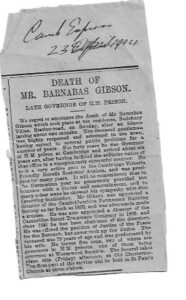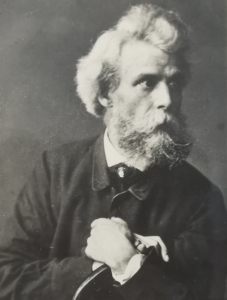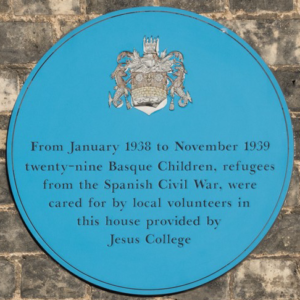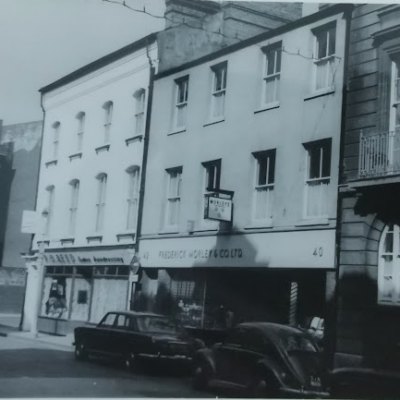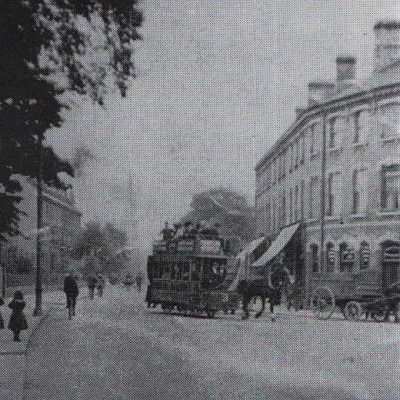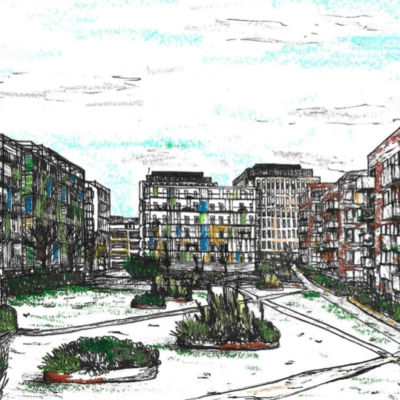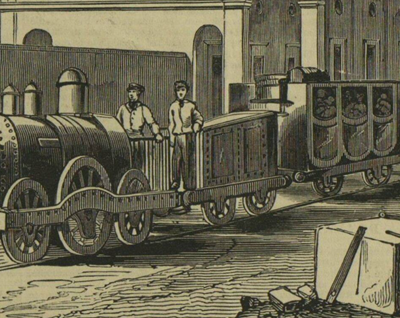Search by topic
- archaeology
- Building of Local Interest
- charity
- church
- crime
- dressmaker
- fire
- Great Eastern Railway
- Listed building
- Mapping Relief
- medieval
- oral history
- poverty
- Public House
- Rattee & Kett
- Religious House
- Roman
- scholar
- school
- Then and Now
- tudor
- women
- work
- world war one
- world war two
Search by text
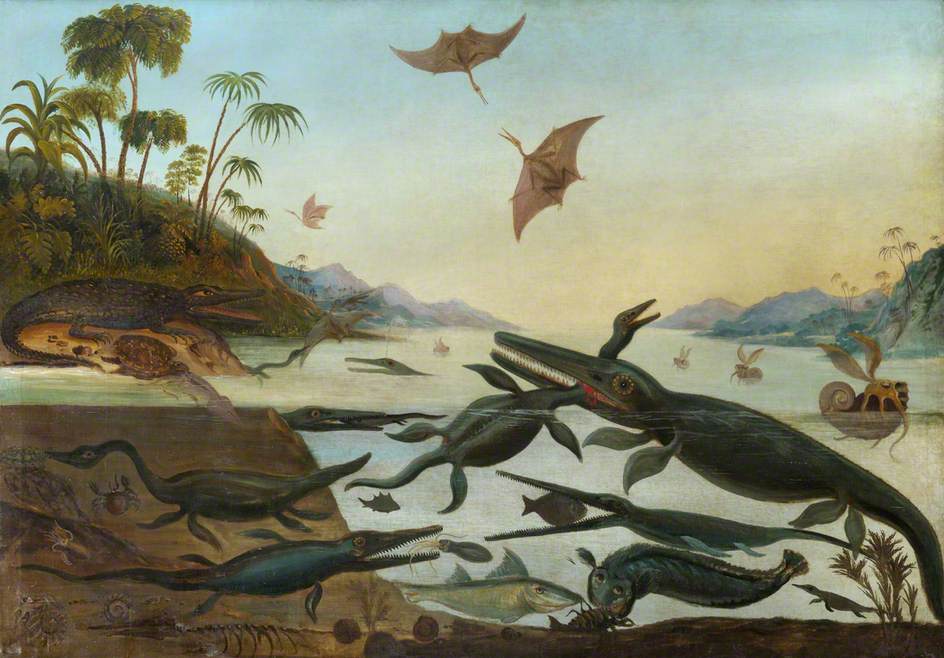 Life in the Jurassic Sea, Robert Farren c1850, Sedgwick Museum Cambridge
Life in the Jurassic Sea, Robert Farren c1850, Sedgwick Museum Cambridge29 Station Road, 1 Salisbury Villas (Basque Refugee Hostel)
History of 29 Station Road
Group of houses built c1874 possibly by Richard Reynolds Rowe. Arundel Villas are two pairs of semis which had their own shared access. Salisbury Villas were six detached properties with another shared access whilst in-between was the largest house, St Andrew’s, which had its own double access to Station Road. All the properties are similar in style, of 2-3 storeys with semi basements, of gault brick with red brick and stone dressings and slate roofs. Whilst all the buildings are different, they share common features and mostly Gothic detailing; Most have prominent gables and end chimney stacks (except no. 13) and plate glass sash windows.
The original separate (but shared) accesses have now been consolidated into one combined access road / car park, though the lime trees adjacent to the road and ‘no-fines’ concrete boundary wall is of interest in its own right.
This is a fine group of houses of consistent character, probably by an architect of some note (his Corn Exchange and Red Cow PH are Grade II Listed). They should be considered for ‘spot-listing’. In townscape terms, the no-fines concrete wall to Station Road is of interest and the rhythm of the set-back houses and avenue of trees are vital to the character of Station Road. Most of the buildings retain their rear gardens though these do not contribute greatly to the townscape, with the exception of the brick wall to no 29 which defines the edge of Tenison Road. (Camb City Council Station Area Conservation Appraisal)
An on-line exhibition about the Basque Refugees who came to East Anglia including Cambridge will be accessible via this link in June 2020:
See below for more information on the role this house played as a hostel for some of the refugee children.
1891
(1 Salisbury Villas)
John S Winbolt [Hinbolt?], 50, civil engineer, born Middlesex
Christiana, 49, born Kennington
Annie P Barton, servant, 36, cook, born Beds
Susan Good [Cook?], servant, 35, housemaid, born Cambs
1901
Barnabas Gibson, 76, retired Governor of Prison, born Leeds
Mary A Matthews, cook, born Comberton
Esther Ison, housemaid, born Cambs
1904
The late Mr Barnabas Gibson, J.P. Cambridge Evening News Saturday 23 April 1904:
Many well-known townsmen were present at St Paul’s Church and Old Chesterton Churchyard on Friday afternoon out of respect to the memory of Barnabas Gibson, whose decease has given rise to much regret. Though for the past few years he had lived quietly at his residence, Salisbury Villa, Station Road, Mr Gibson was reckoned among the leading burgesses of Cambridge. In local government he took no part, though his keen business capacity was felt in philanthropic organisations and successful commercial undertakings. For forty years he was Governor of H.M. Cambridge prison, a position he fulfilled in a manner which won him golden opinions. About six years ago he retired with a well earned pension. It is probably that while governor of the prison Mr Gibson acquired that brusque manner which concealed his kindly motives. Possessing all the characteristics of a north countryman, his plain speaking at first surprised and then attracted his associates. Whatever Mr Gibson thought he said, and all his dealings were marked by the same transparent honesty. He was a man who chose to exercise his charitable proclivities in secret, and there probably is no man living who knows the number of persons he helped in a quiet way, sometimes with a threat to withhold further help if anyone were informed of his charity. The one institution which fulfils charitable objects with the full blaze of publicity , in which Mr Gibson took an active part was the Cambridge Victoria Friendly Benefit Societies’ Asylum, of which he was president for many years. He was also well known as chairman of the Cambridge street Tramways Company, and when in good health he might be seen walking slowly up to the centre of the town carefully taking note of the tramcars, or conferring with the tram manager. In the Cambridgeshire Permanent Building Society he had played a large part. As far back as 1869 he was appointed director and have been a trustee since 1891.
Some years ago he was placed upon the list of local Justices of the Peace, but he never exercised his right of adjudicating.
The first part of the service took place at St Paul’s Church, the Rev Dr Stokes assisted by the Rev Merrin, officiating. The mourners were:
The Rev W Gibson, Mr H. Gibson, Mr Frank Gibson, and Mr Fredk Gibson (sons); Mr C Stretten, M.V.O.(Cambs Chief Constable), Mr Josiah Chater, and the servants of the house-hold. Among those present at the church were :
Messrs C.Armstrong, J. Sturton (Directors of the Tramway Company), A.Chater (assistant secretary), W.H.Fairey (manager), A. Mason, W.E. Lilley, A. Macintosh, F.Piggot, E.R. Barrett, W.P. Spalding, G.Stace, J.Taylor, and H.E.Verrinder (Directors of the Building Society); G.Peck (former director), J.H. Moyes (surveyor), J.E.Foster (solicitor), J.Catling (auditor), J.G.Bland (secretary), A.E.Rutter (assistant secretary), A.Rutter (former secretary), F.French (Friendly Societies’ Asylum), C.J. Clay, T.Coulson, H.E. Greef, T.B.Bumpstead, J.V.Prior, G.W.Hattersley, O. Papworth , &c
The interment took place at Old Chesterton churchyard, the deceased being laid next the remains of his wife, who predeceased him. The coffin, which was of plan oak with brass fitting, bore the inscription:
BARNABAS GIBSON, J.P., Died April 17th , 1904 Aged 79 years
Wreaths were sent from relatives, Mr Matthews and family, and the inmates of the Victoria Asylum.
Messrs Eaden Lilley and Co. carried out the funeral arrangements.
1911
Robert Farren, 79, widower, oil and water colour painter, born Cambridge
Mary Farren, 55, daughter, single, oil and water colour painter, born Cambridge
Anne Coe, 53, married, artist painter, born Cambridge
Nellie Coe, granddaughter, 24, born Cambridge
Jessie Farren, 52, daughter, artist painter, born Cambridge
Alexander Farren, son, artist, born Cambridge
Emma Grace farren, son’s wife, 40, born Cambridge
Daphne Farren, granddaughter, 7, born Cambridge
Ivy Elizabeth Brown, servant, 15, born Cambridge
Robert Farren (1832-1912) was born in Willow Walk, Newmarket Road and worked as a heraldic artist and in the Geological Museum mounting specimens and labelling cases. He published engravings of local scenery. His brother William Farren was a photographer and the two brothers joined together and created Farren Brothers in 1869. They split in 1870 and William Farren continued the photography business.
20/12/1920 Robert Farren, the well-known Cambridge artist, died at Highgate. Farren, who was born in Cambridge about 80 years ago, lived in Cambridge all his life with the exception of a few years’ residence at Scarborough until August last when he went to live in Highgate. He was a very clever water colour artist but best known for his work in oils and his etchings. His fen pictures were well- known and his series of etchings of cathedral cities amongst his most famous work. He also produced fine etchings of the Cambridge Greek plays. His ‘Degree Day’ was published as a photo by Wm Farren when he lived in Rose Crescent. Farren loved to paint Cambridge & Cambridgeshire scenery and there is scarcely a picturesque ‘bit’ in the town or county that has not been reproduced by him. At one time he had his studios at the top of which are now the University offices but were formerly a Liberal Club. A good many years ago he resided at Mayfield, Hills Road but during the last three years lived at no. 1 Station Road. In his younger days he was a very handsome figure, tall and well- built. He was a skilful fencer and attained some note as a geologist. He married Miss Mason, a Cambridge lady and had a family of 14 children, none of whom are now living in Cambridge, his only relatives being his nephew William Farren, the naturalist, of Regent Street and his brother. Two of his daughters have inherited their father’s artistic skill in no small degree. The funeral will take place at Old Chesterton churchyard where his wife is buried. Three children of his eldest son, the late Ernest Farren live with their mother in Herbert Street (Cam.News)
1913
Mrs Griffiths
1938
Jesus College rented the house to be used as a refuge for Basque Children, evacuated to the UK to escape from the Spanish Civil War. An important figure in the support given to the refugees was Professor Francis Macdonald Cornford (1874-1943). He was an ancient historian whose son John had been a poet and Communist; he was killed in the Spanish Civil War. The family home was Conduit Head on Madingley Road.
John Cornford and the fight against the Fascists in the 1930s.
1939 UK Register
1.Maria Eckroyd, b 1890, teaching
2.Marina Rodriguez, b 1902, matron
3.John A McLean, b 1911, lecturer adult education (Gunner Royal Artillery)
4.withheld
5.withheld
6.Jose Gallego, b 1923, garage apprentice
7.withheld
8.Antonio Gallego, b 1924, garage apprentice
9.withheld
10.withheld
11.withheld
12.withheld
13.withheld
14. Antonio Montero, b 1926, at school
15. Amparo Moreno, b 1926, at school
16. withheld
17.Alvara Martinez, b 1927, at school
18.withheld
19.withheld
20.withheld
21. Maria T Cisneros, b 1928, at school
22.withheld
23.withheld
24.withheld
25. Jose E Murquia, b 1928, at school
26.withheld
27.withheld
28. Carmen Margalet, b 1930, at school
29. withheld
30. Carmen Martinez, b 1900, matron
Jose and Antonio Gallego were two of the refugees who stayed in England after the war and went on to become professional footballers.
https://english.elpais.com/elpais/2012/05/22/inenglish/1337695459_091784.html
More information about the Basque refugees in general can be found in these locations:
https://www.cambridgeppf.org/faqs/basque-refugees
https://www.iwm.org.uk/memorials/item/memorial/65794
https://www.basquechildren.org/-/docs/newsletters/20070401
https://eprints.soton.ac.uk/343357/1/SABIN-FERNANDEZ_Doctoral_Thesis_BASQUE_REFUGEE_CHILDREN.pdf
Contribute
Do you have any information about the people or places in this article? If so, then please let us know using the Contact page or by emailing capturingcambridge@
License
This work is licensed under CC BY-NC-SA 4.0






